Introduction
Education is widely regarded as a cornerstone of opportunity and growth, yet my journey through the K–12 public school system revealed the complexities and inequities that can underlie this ideal. Throughout my formative years, I grappled with persistent and compounding educational gaps — particularly in fundamental skills such as literacy, numeracy, and comprehension. These deficits were not merely academic challenges; they shaped my experience and self-perception in profound ways. This reflection is significant to me because it chronicles how supplemental services transformed what initially seemed like insurmountable barriers into stepping stones for growth. It offers insight into the interplay between systemic support and individual perseverance, demonstrating how each is necessary to bridge gaps and foster success.
Early Challenges
The earliest years of schooling, from first to fifth grade, are critical for establishing the foundations upon which all subsequent learning is built. For me, these years were marked by persistent struggles to master basic concepts that many of my peers seemed to absorb naturally. This gap in foundational knowledge made each subsequent academic year feel like an uphill climb — akin to constructing a house without a stable base.
Complicating these challenges was the inconsistency in how educational supports were applied. Although I had an Individualized Education Program (IEP), designed to tailor instruction and accommodations to my needs, its implementation was often irregular. At times, necessary accommodations were altered or withdrawn without prior consultation, which disrupted my learning routine and introduced uncertainty. This unpredictability eroded my trust in the educational system and necessitated a premature cultivation of self-advocacy and resilience.
Discovering Supplemental Services
Recognizing early on that the traditional classroom environment alone was insufficient to meet my learning needs, I gradually sought additional resources beyond standard instruction. My educational experience became characterized by a dual engagement with both general education classrooms and specialized supplemental services, including occupational therapy, physical therapy, mentoring, and assistive technology. These services were designed to narrow the divide between my current skill set and the grade-level expectations.
However, accessing these supports was not without its hurdles. The path was often complicated by bureaucratic obstacles, inconsistent communication, and at times, a lack of understanding from educators unfamiliar with the nuances of my needs. Substitute teachers, for instance, sometimes disregarded my IEP accommodations during assessments, denying critical supports such as extended time or oral test administration. Beyond the classroom, I also faced the “homework gap.” While I had internet access at home, I lacked specialized software and devices necessary to complete certain assignments effectively, especially in subjects like English and mathematics. This technological disparity became particularly consequential during standardized testing periods, when failure could have jeopardized my progression despite federal protections.
The Role of Supplemental Services
Supplemental services were far more than remedial interventions; they constituted essential scaffolding that allowed me to engage with academic content in a meaningful way. These supports translated abstract, rapidly delivered instruction into digestible components, affording me the time and structure necessary to consolidate understanding before progressing. They equipped me not only with knowledge but also with strategies to approach learning proactively, even when expectations were unclear or shifting.
Beyond academics, supplemental services fostered a critical sense of self-efficacy and belonging. My parents’ proactive involvement — seeking out community programs, public libraries, and recreational centers that celebrated ability over limitation – reinforced this empowerment. These environments helped reframe my identity, encouraging me to see myself as capable and resilient rather than defined by my challenges.
Growth Over Time
My classification on the autism spectrum shifted from Level 2 to Level 1 as I progressed through school, a change that reflected not the eradication of challenges, but a growing capacity for self-management and adaptation. By high school, I had cultivated a personalized toolkit of skills and coping mechanisms, allowing me to navigate academic and social obstacles with increasing independence.
This evolution did not end with formal schooling. As an adult, I continue to engage with supplemental learning through platforms like LinkedIn Learning and Khan Academy, embracing a lifelong commitment to growth. These resources provide flexible opportunities to revisit difficult concepts, acquire new skills, and pursue professional development, underscoring that education is an ongoing journey rather than a finite destination.
Reflections
Reflecting on this journey, I recognize that the interplay between external support and personal agency was pivotal. While supplemental services laid the groundwork, it was ultimately my willingness to engage, persist, and advocate for myself that propelled my progress. The adage “aptitude determines altitude” encapsulates this truth: inherent potential must be met with effort and determination to translate into achievement.
Unexpectedly, I found that consistently surpassing low expectations, sometimes quietly set by others, transformed my conception of success. Growth became less about comparison and more about resilience and persistence. This experience also reshaped my understanding of education as nonlinear and multifaceted, requiring adaptability and self-advocacy as essential components.
Advice and Call to Action
To individuals facing similar educational gaps, I offer this counsel: do not allow the skepticism or limitations imposed by others to define your aspirations. Demonstrate your capabilities through action, and view setbacks as temporary challenges rather than permanent barriers. Every incremental step forward is meaningful progress.
For educators and policymakers, the imperative is clear: supplemental services must be proactive, consistent, and integrated into the educational framework from the earliest signs of need. Waiting until crisis points before intervention only compounds disparities. Effective support requires collaboration among educators, service providers, policymakers, and the voices of students themselves. Bridging divides between special and general education, and supporting diverse pathways beyond traditional academics, will foster more inclusive and equitable learning environments.
Conclusion
My educational path, once fraught with instability and uncertainty, evolved through the confluence of supplemental services and personal resilience into a story of strength and ongoing growth. Supplemental supports were not mere add-ons; they were foundational in transforming gaps into gateways. This reflection underscores the critical need for accessible, adaptive, and anticipatory educational supports that empower all learners to realize their potential. Education’s promise is fulfilled only when it acknowledges and addresses the varied and uneven foundations upon which students begin their journeys.
Thank you for taking the time to consider these reflections; together, our awareness and efforts can contribute to creating more equitable educational opportunities.
Warm Regards,
Ian Allan
Self-Advocate for The Arc of Northern Virginia
Ian Allan is a self-advocate with a deep commitment to policy literacy, systems change, and disability justice. Through The Arc of Northern Virginia, he works to ensure that people with intellectual and developmental disabilities are not merely served by systems, but are actively shaping them.

